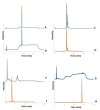Combined Effects of Exercise and Phytoanabolic Extracts in Castrated Male and Female Mice
- PMID: 33918334
- PMCID: PMC8066446
- DOI: 10.3390/nu13041177
Combined Effects of Exercise and Phytoanabolic Extracts in Castrated Male and Female Mice
Abstract
Dry extracts from the Eurasian plants, Ajuga turkestanica, Eurycoma longifolia, and Urtica dioica have been used as anabolic supplements, despite the limited scientific data on these effects. To assess their actions on early sarcopenia signs, male and female castrated mice were supplemented with lyophilized extracts of the three plants, isolated or in association (named TLU), and submitted to resistance exercise. Ovariectomy (OVX) led to body weight increase and non-high-density cholesterol (HDL) cholesterol elevation, which had been restored by exercise plus U. dioica extract, or by exercise and TLU, respectively. Orchiectomy (ORX) caused skeletal muscle weight loss, accompanied by increased adiposity, being the latter parameter reduced by exercise plus E. longifolia or U. dioica extracts. General physical activity was improved by exercise plus herbal extracts in either OVX or ORX animals. Exercise combined with TLU improved resistance to fatigue in OVX animals, though A. turkestanica enhanced the grip strength in ORX mice. E. longifolia or TLU also reduced the ladder climbing time in ORX mice. Resistance exercise plus herbal extracts partly altered gastrocnemius fiber size frequencies in OVX or ORX mice. We provide novel data that tested ergogenic extracts, when combined with resistance exercise, improved early sarcopenia alterations in castrated male and female mice.
Keywords: Ajuga turkestanica; Eurycoma longifolia; Urtica dioica; aging; ergogenic phytotherapics; mice; orchiectomy; ovariectomy; resistance exercise; sarcopenia.
Conflict of interest statement
The funders had no role in the design of the study; in the collection, analyses.
Figures














References
MeSH terms
Substances
LinkOut - more resources
Full Text Sources
Other Literature Sources
Medical

